DeFi
Top 5 winners and losers: CWB.TO, HPQ.V, DEFI.NE

In this summary report, we’ll take a quick look at the top 5 winners and losers up or down double digits in the Canadian stock markets.
Here’s a summary of the assets’ intraday action:

HPQ Silicon (HPQ.V)
Market capitalization ~$118 million
HPQ Silicon Inc., together with its subsidiaries, provides silica and silicon solutions in Canada. It is also developing a portfolio of silicon and silica-based products mainly intended for manufacturers of batteries and electric vehicles, Li-Ion batteries; and hydrogen applications. Additionally, the company is engaged in the development of PUREVAP quartz reduction reactors, a process for transforming quartz into metallic silicon; PUREVAP fumed silica reactors, a plasma-based technology that converts quartz raw material into fumed silica; and PUREVAP Nano Silicon Reactors, a process for manufacturing spherical nano-silicon powders and wires. In addition, it is involved in the manufacturing of nanoscale silicon materials.
The stock is up 18% following the announcement of latest steps taken in batteries by its subsidiary based in France, NOVACIUM SAS (“Novacium”). This announcement highlights the remarkable results achieved in initial 50-cycle testing of 18650 industrial batteries manufactured with Novacium’s unoptimized, second-generation advanced silicon-based anode material.


We confirmed an inverted head and shoulders pattern was triggered. Bullish. This trend actually started at yesterday’s close. We have a great sequel today with this news. The next resistance area lies at $0.40.
DeFi Technologies (DEFI.NE)
Market capitalization ~$693 million
DeFi Technologies Inc., a technology company, develops and lists exchange-traded products in Canada, Bermuda and the Cayman Islands. The Company provides asset management services, such as investment vehicles, indirect exposure to underlying cryptocurrencies, digital asset indices and other decentralized financial instruments. It also participates in decentralized blockchain networks by processing data transactions that contribute to network security and stability, governance and validation of transactions. Additionally, the company invests in decentralized finance companies in early-stage projects.
The stock is up 25% with no news. Yesterday, the The company announced that it has deployed a Core Chain validator node to act as an independent validator for the network. The node launch is part of the company’s DeFi Infrastructure business line, contributing to the mission of decentralized finance. The company will also stake 1,498 BTC on the Core Chain.
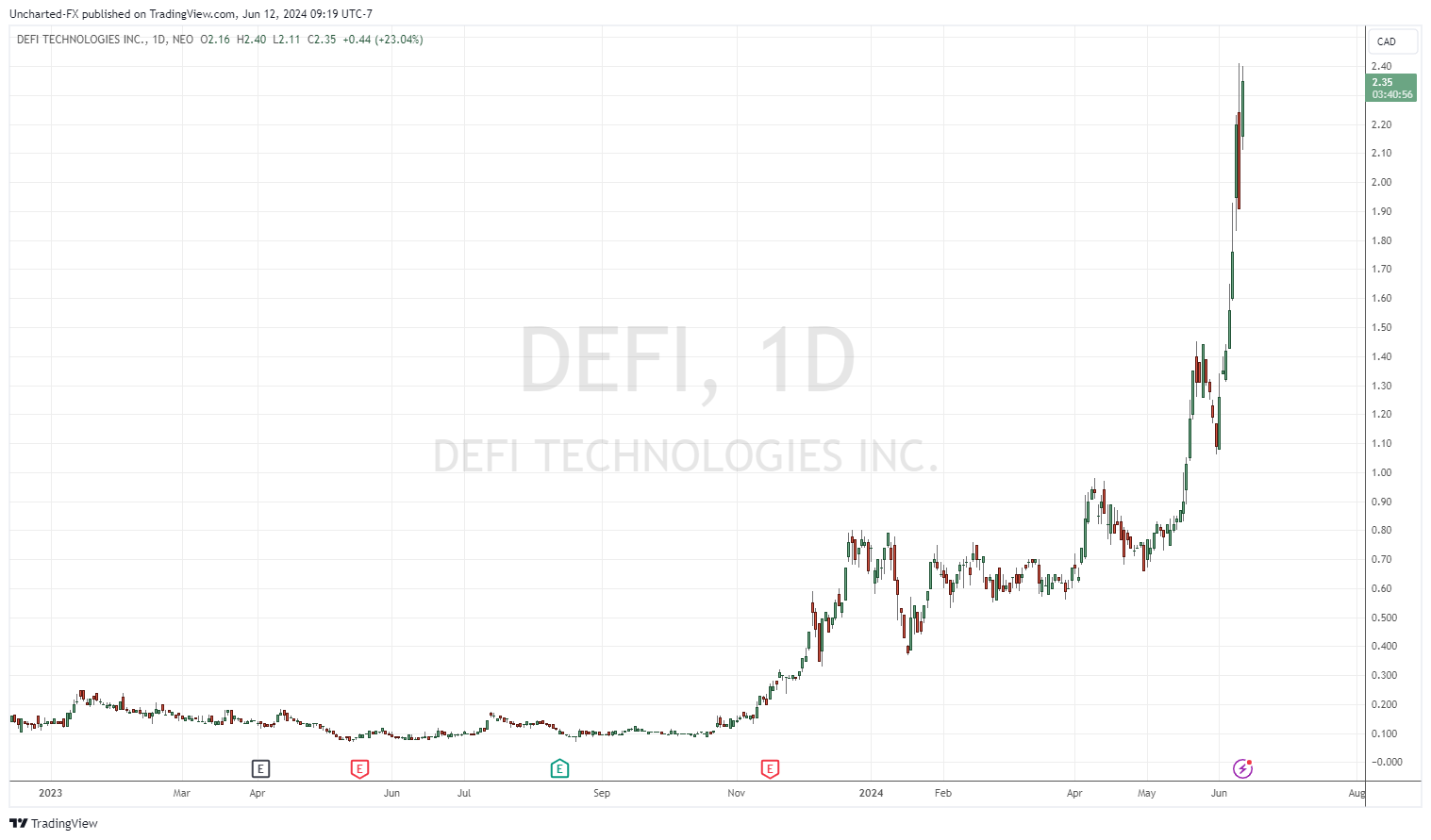

The stock is in a strong uptrend. We are currently testing the $2.40 zone. There is still room for upside. If the stock can close above $2.50, watch for a move toward $3.20.
Canadian Western Bank (CWB.TO)
Market capitalization ~$4.09 billion
Canadian Western Bank offers personal and commercial banking products and services in Western Canada. The company offers checking, savings, U.S. dollar, checking, flexible notice, organization, business trust and trust fund investment accounts. It also offers commercial lending and real estate products, equipment financing and leasing, aviation financing and dealership financing products; agricultural loan products and AgriInvest savings account; variable and fixed rate mortgages; credit line; registered retirement savings plan, consolidation and automobile loans; and credit cards.
The stock is up 70% following the announcement that it is bought by the National Bank for $3.6 billion. The buyer will pay the equivalent of CA$52.24 per share for Canadian Western, a premium of 110% over Tuesday’s target closing price.
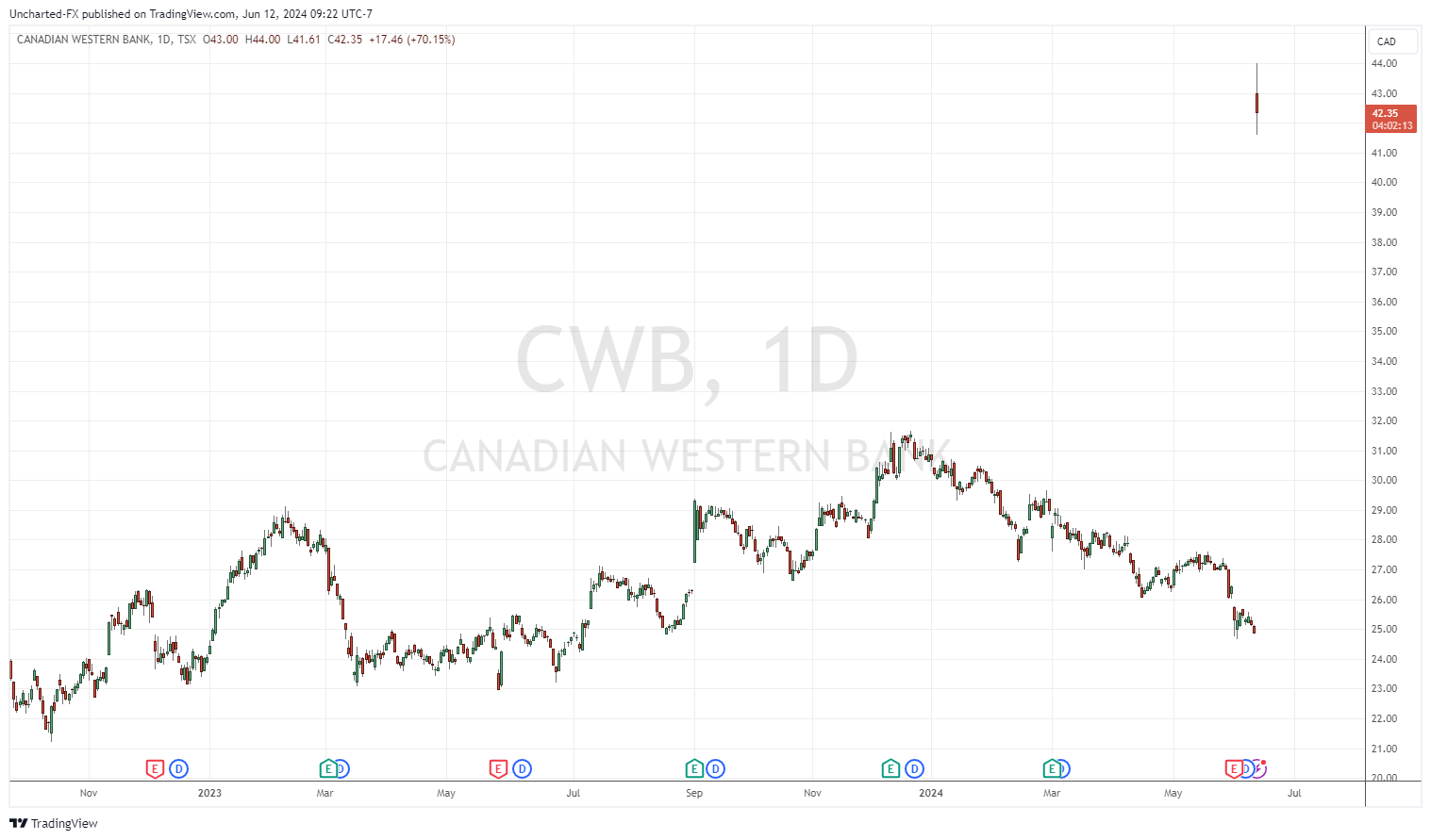

The title reached new all-time highs following this big news. The buyout price is $52.24, but the approval of the Canadian government and two-thirds of CWB shareholders (who must vote at a special meeting in September) is still required for this transaction to be completed. concluded.
Mineral Showcase (SHOW.CN)
Market capitalization ~$16 million
Showcase Minerals Inc. engages in the identification, acquisition, exploration and development of mineral projects. The company mainly explores gold and vanadium deposits. It has interests in the Dixie Flats, which consist of 180 unpatented vein claims covering approximately 1,311 hectares; the North Star, which includes 56 unpatented vein claims covering 360 hectares; and Woodruff, which consist of 18 unpatented lode claims covering approximately 147 hectares located in Elko County, Nevada.
The stock is up 25% with no news.
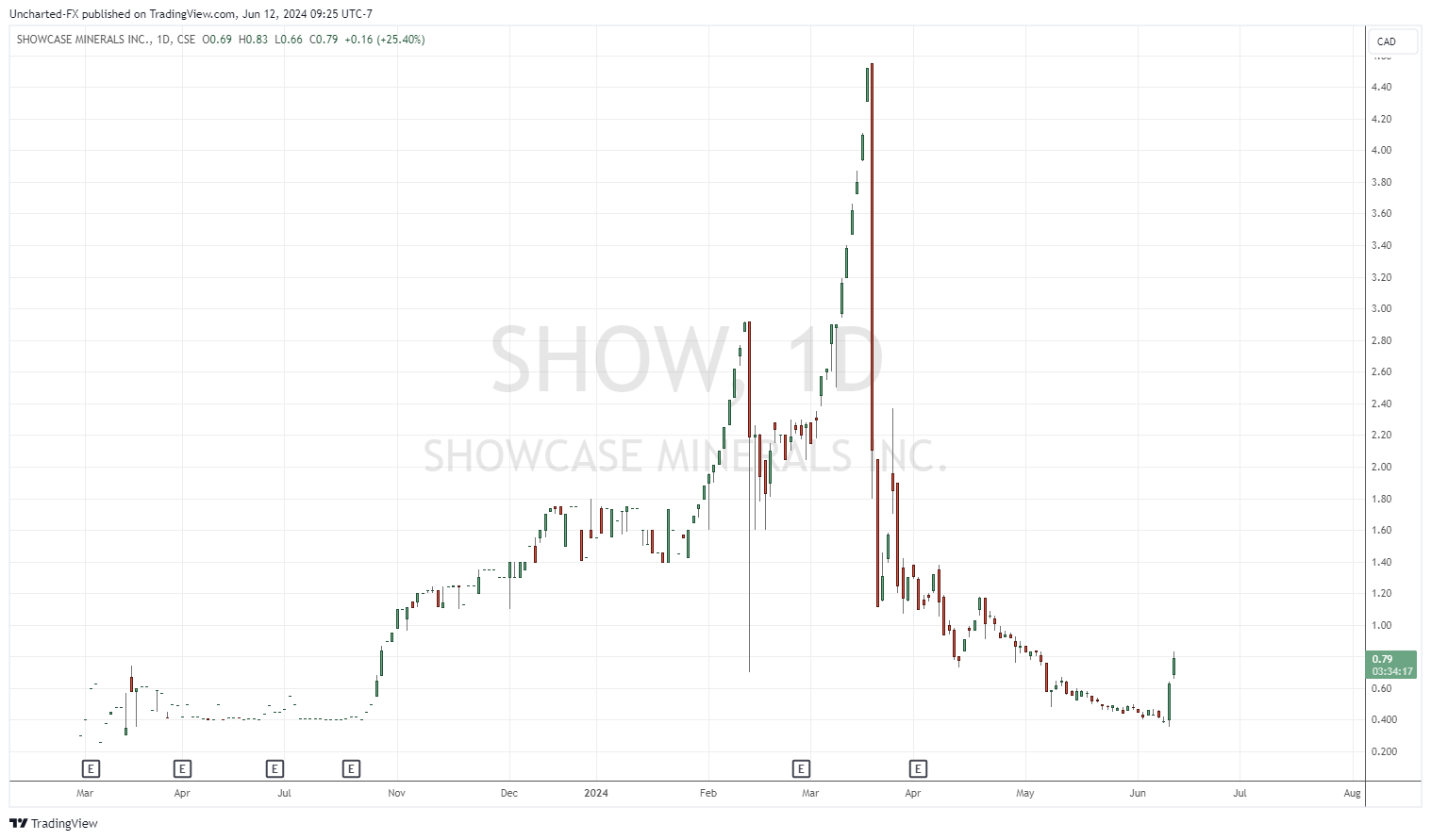

A lovely engulfing candle was printed yesterday. The bulls made a strong statement in favor of a bottom and a trend reversal. The stock is testing the resistance zone at $0.78 here. Watch for a fence above this level.
Noram Lithium Corp (NRM.V)
Market capitalization ~$12 million
Noram Lithium Corp. is engaged in the acquisition, exploration and development of mineral properties in the United States. Its flagship property is the Zeus Lithium project consisting of 146 placer claims and 136 lode claims covering an area of approximately 1,113 hectares located in Clayton Valley, Nevada.
The stock is up 22% following the announcement of the closing of a updated mineral resource estimate for its 100% owned Zeus Lithium project.
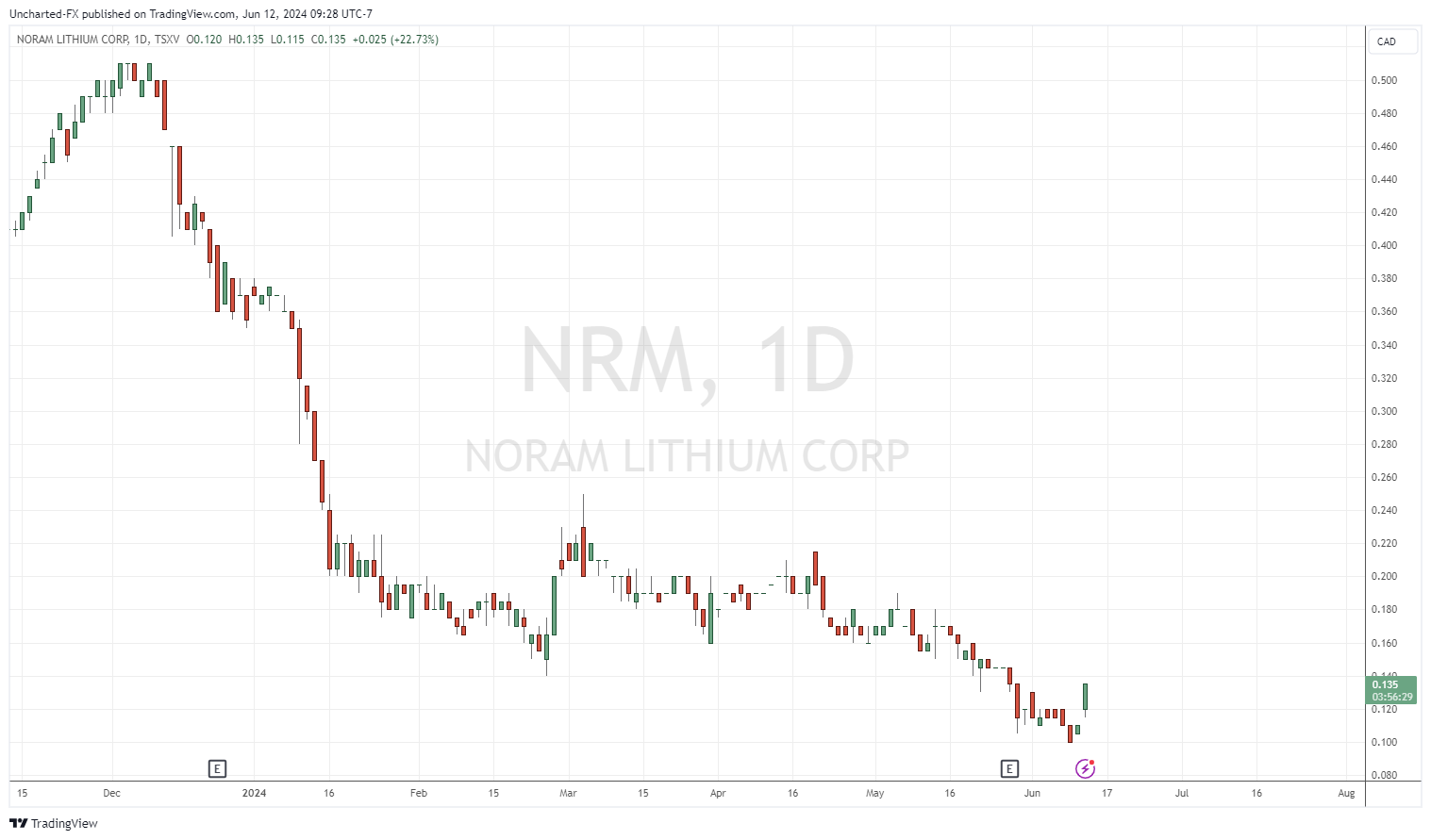

The stock appears to have found support at $0.10 and is lagging behind today’s news. The market likes mineral resource estimates. The current high stands at $0.15. Watch for a close above this level to confirm a new trend.
KWESST Microsystems (KWE.V)
Market capitalization ~$6.8 million
KWESST Micro Systems Inc. is engaged in the development and marketing of tactical systems and munitions for the military, public safety agency and personal defense markets. The company produces non-lethal products, including PARA OPS devices and ARWEN products.
The stock is down 30% with no news. Two days ago, the Company announced that it had been obtained a subcontracting contract with Thales Canada. Under the subcontract, KWESST will provide specialized software services for work under the Canadian Department of National Defense’s C4ISR land contract series aimed at modernizing the capabilities of the Canadian Army through advanced command, control, communications, computers, intelligence, surveillance and reconnaissance (C4ISR). ) systems. A contract valued at $48 million.
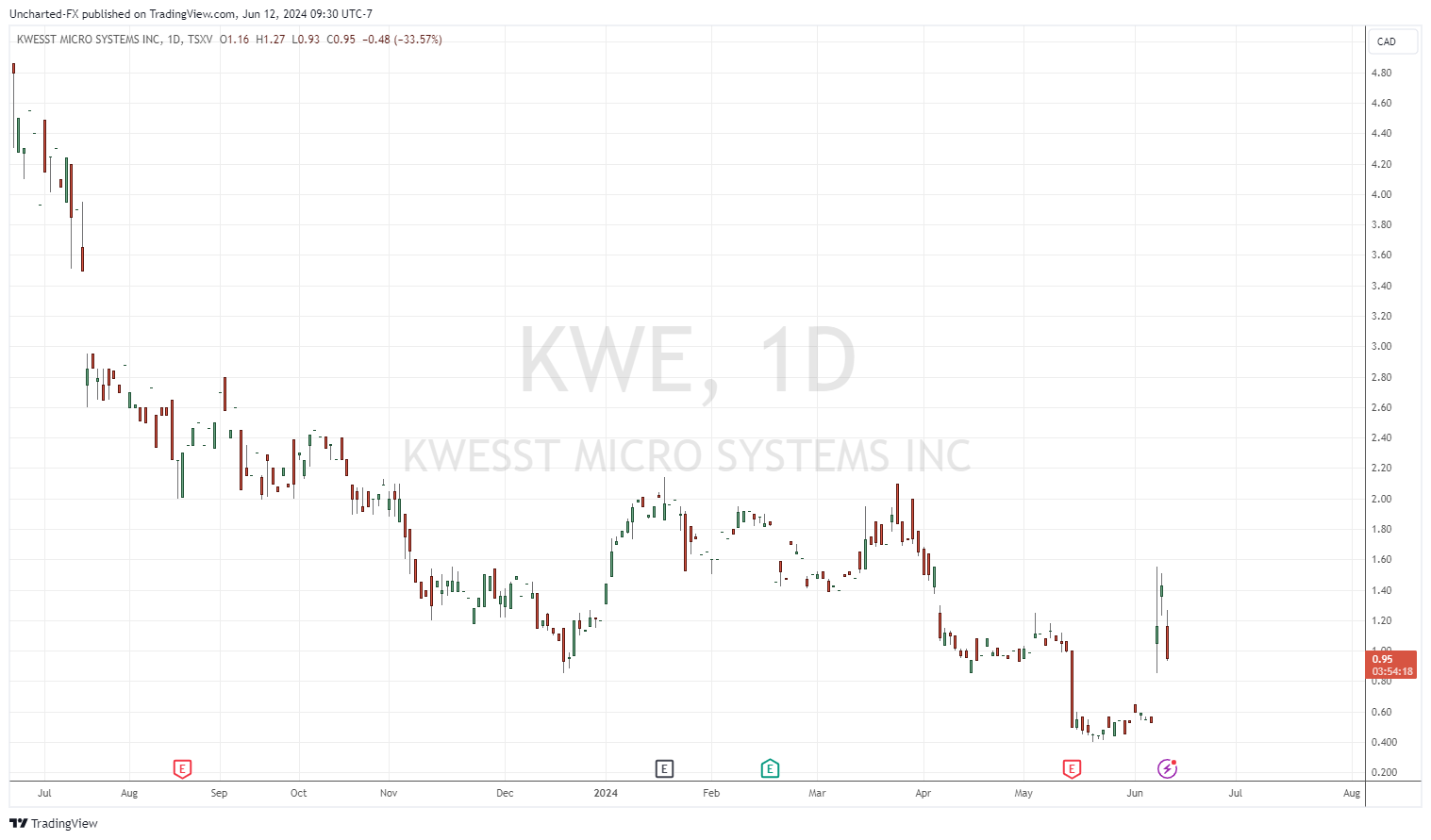

We are seeing profit taking after a major two-day move. The stock confirmed a close above the lower high of $1.20, but selling pressure is strong and the stock is back below the key psychological zone of $1.00. Watch to see if the bulls will return to confirm a close above $1.00.
Genesis AI Corp (AIG.CN)
Market capitalization ~$6 million
Genesis AI Corp. has no significant activities. Previously, she was engaged in the development of cybersecurity and cryptocurrency software.
The stock is down 13% with no news.
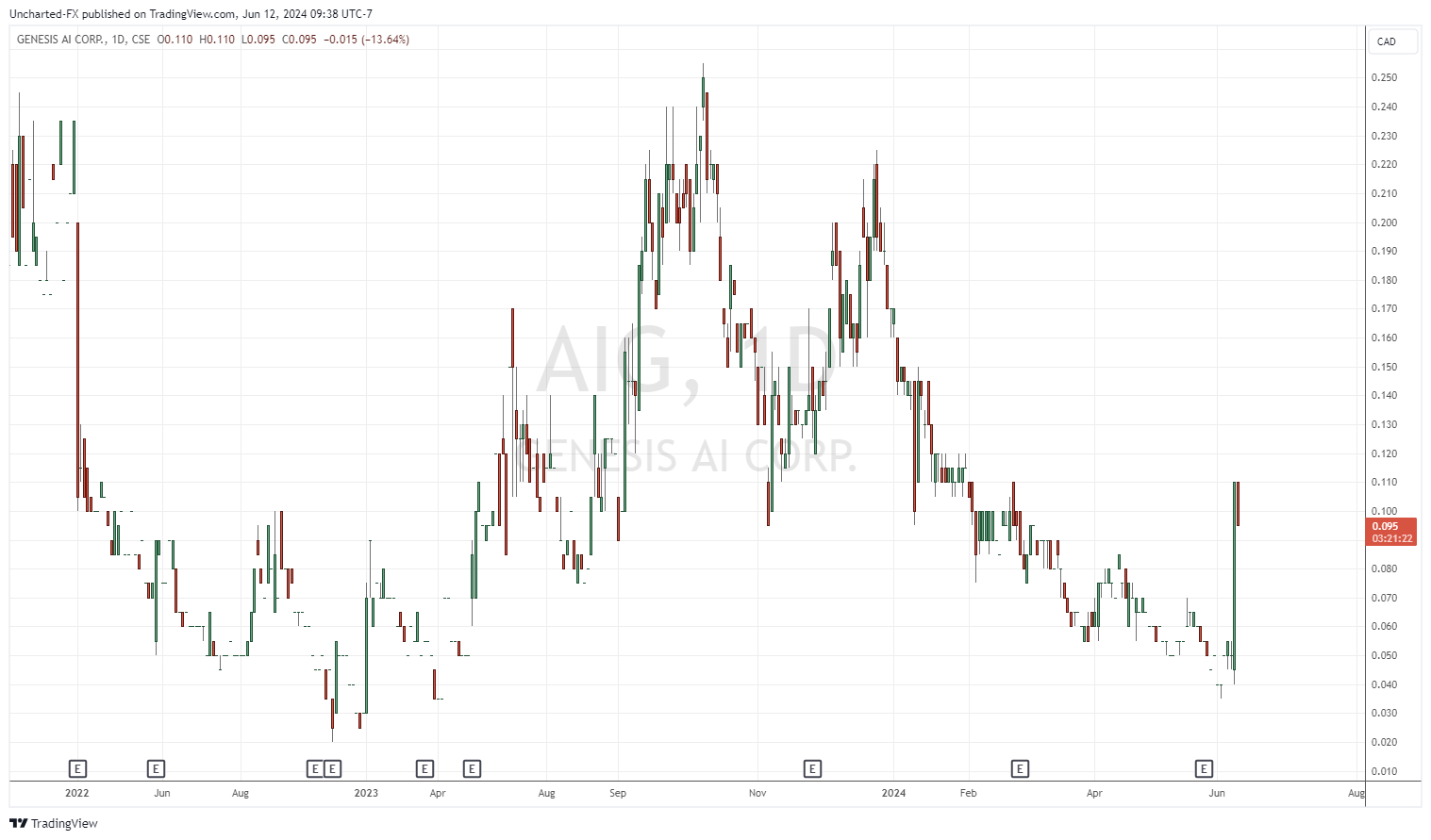

The stock is pulling back in what could be a new uptrend after yesterday’s engulfing candle. There’s not much for the bulls to worry about unless the stock closes below $0.07.
Cannabix Technologies (BLO.CN)
Market capitalization ~$58 million
Cannabix Technologies Inc., a technology company, develops marijuana-based breathalyzers for employers, law enforcement, workplaces and laboratories in the United States. It is developing tetrahydrocannabinol breath analyzers, a point-of-care breath analysis tool for rapid detection of recent cannabis use; MS breath sampler; and a contactless breathalyzer, as well as breath collection units.
The stock is down 12% with no news.
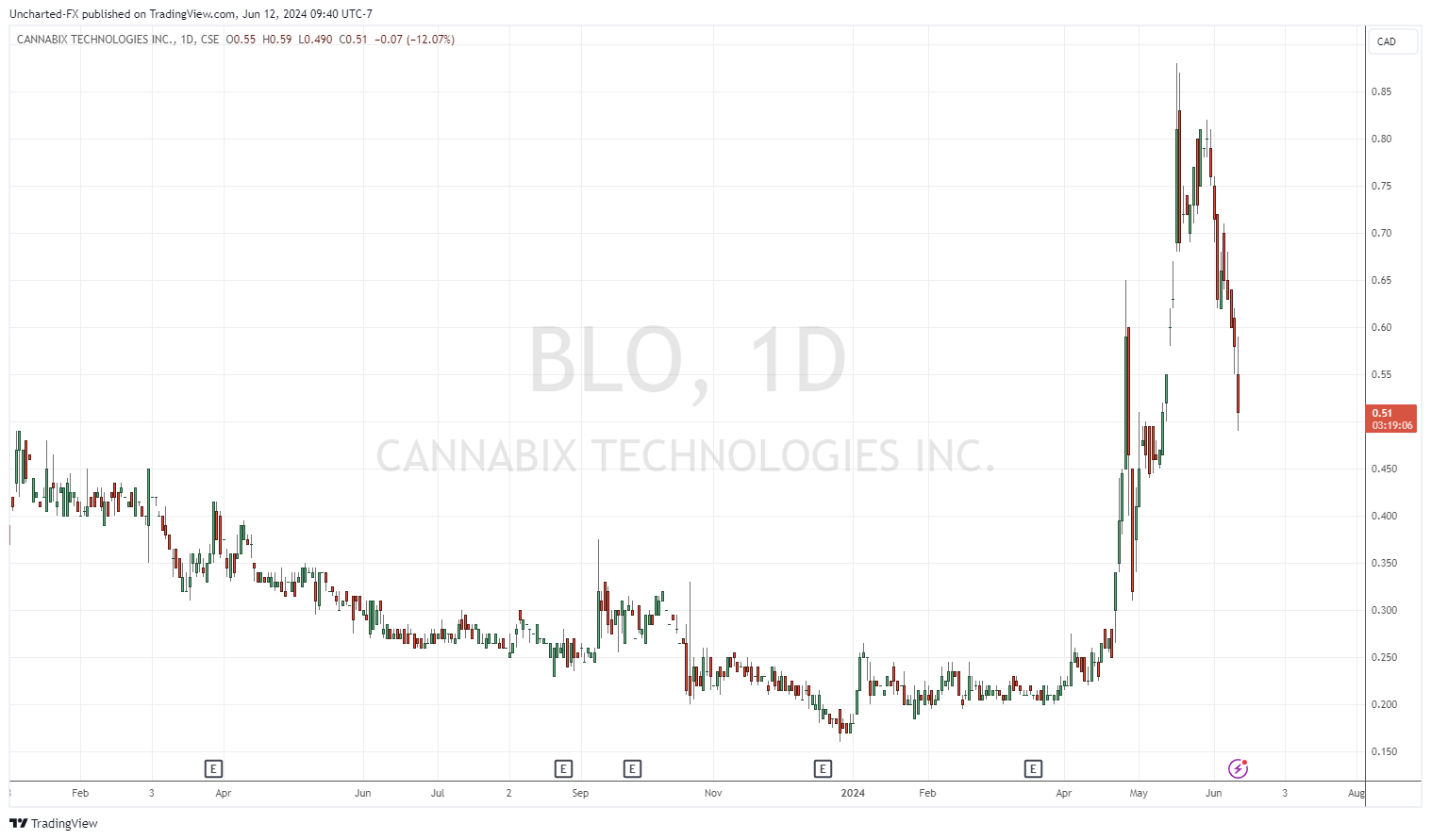

Profits are made after the stock reaches the $0.85 area. The stock is currently testing the key psychological zone of $0.50. A close below would allow the stock to test the all-time high low at $0.45. A close below this level would see the stock fall to $0.30.
Resaas Services (RSS.V)
Market capitalization ~$28 million
RESAAS Services Inc. is dedicated to the development of web and mobile communications software for the real estate industry. The company offers a suite of tools that integrate with the platform, including a global referral network, lead generation engine, SEO management, customer engagement modules, customer relationship management tools , analytics, file sharing, a payment system and an advertising engine. Its solutions also include RealTimeMLS, a real-time listings solution and communications platform for real estate associations and multiple listing services (MLS); and BrokerOS, an online communications hub that ensures agents open, read and respond to emails and messages sent to them by users.
The stock is down 10% with no news.
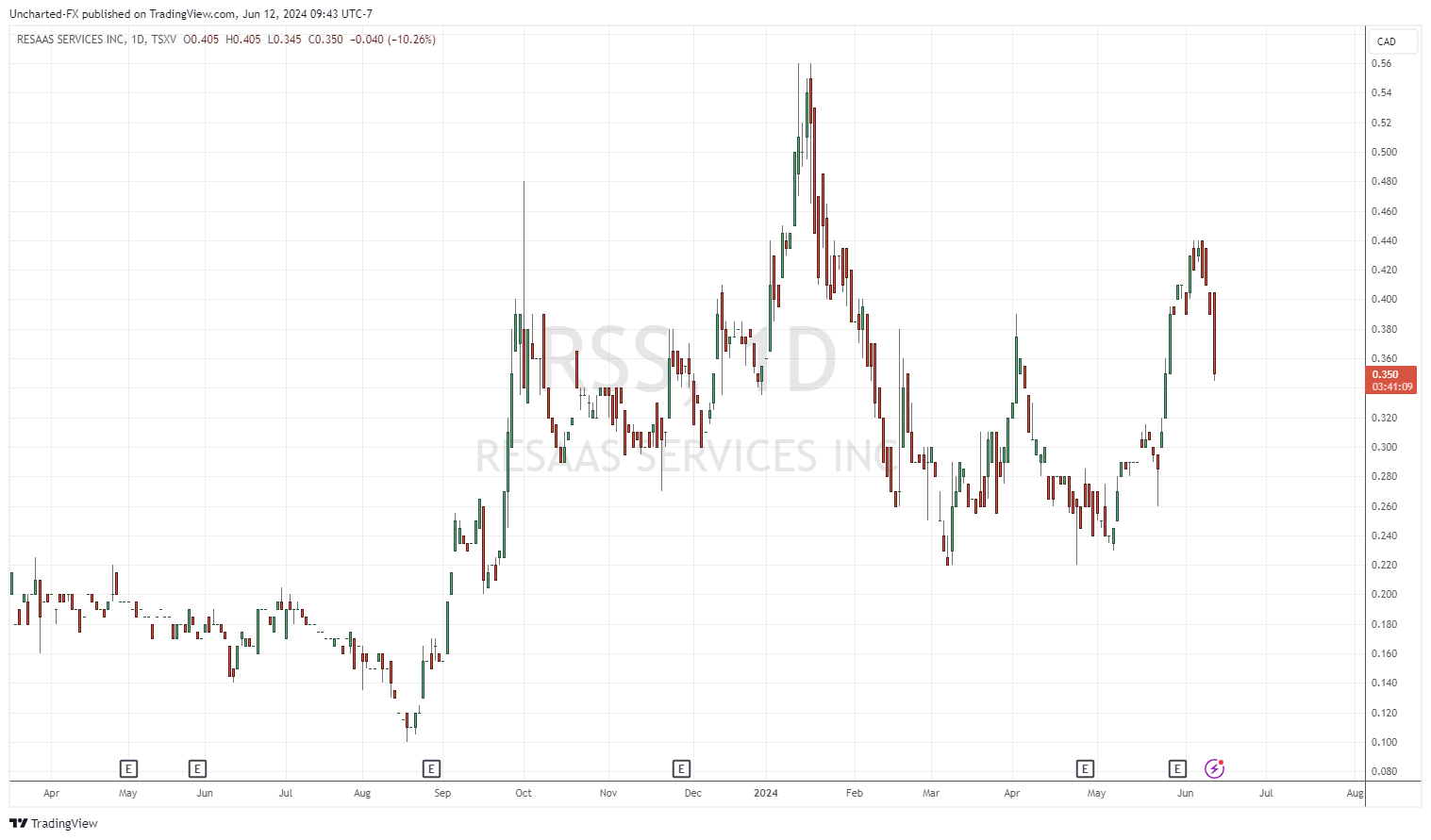

The stock rejects the $0.44 area. A few support levels here, but the next major support stands at $0.30.
Leef Brands (LEEF.CN)
Market capitalization ~$12 million
Leef Brands Inc. operates as a manufacturer of branded cannabis products in the United States. It provides infused resins and pre-rolls. The Company offers its products under the brands Ganja Gold, Real Deal Resin, Heady and LEEF.
The stock is down 33% with no news.
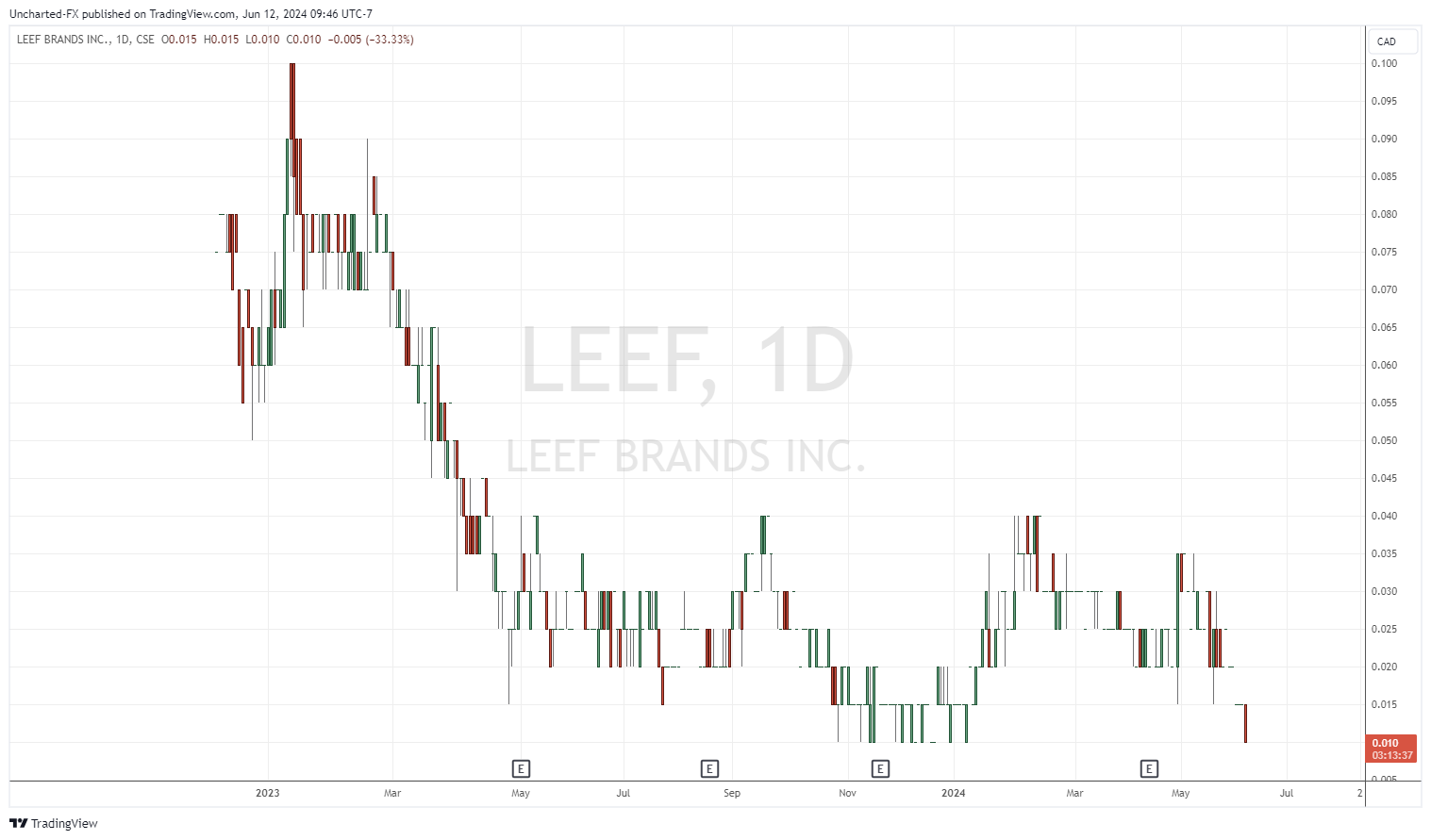

At the low of support at $0.01. Lower pickers should watch for a strong green bodied candle to indicate buyers. This would be a range game with targets at $0.04.
DeFi
Haust Network Partners with Gateway to Connect to AggLayer

Dubai, United Arab Emirates, August 1, 2024, Chainwire
Consumer adoption of cryptocurrencies is a snowball that is accelerating by the day. More and more people around the world are clamoring for access to DeFi. However, the user interface and user experience of cryptocurrencies still lag behind their fundamental utility, and users lack the simple and secure access they need to truly on-chain products.
Haust Network is a network and suite of products focused on changing this paradigm and bringing DeFi to the masses. To achieve this goal, Haust Network has announced its far-reaching partnership with bridgeseasoned veterans in rapidly delivering revolutionary blockchain utilities for projects. The Gateway team empowers blockchain developers to build DAOs, NFT platforms, payment services, and more. They drive adoption of crypto primitives for individuals and institutions around the world by helping everyone build their on-chain presence.
Gateway specializes in connecting sovereign blockchains to the Aggregation Layer (AggLayer). The AggLayer is a single unified contract that powers the Ethereum bridge of many disparate blockchains, allowing them all to connect to a single unified liquidity pool. The AggLayer abstracts away the complexities of cross-chain DeFi, making tedious multi-chain transactions as easy for the end user as a single click. It’s all about creating access to DeFi, and with Polygon’s technology and the help of Gateways, Haust is doing just that.
As part of their partnership, Gateway will build an advanced zkEVM blockchain for Haust Network, leveraging its extensive experience to deploy ultra-fast sovereign applications with unmatched security, and enabling Haust Network to deliver its products to its audience.
The recently announced launch of the Haust Wallet is a Telegram mini-app that provides users with access to DeFi directly through the Telegram interface. Users who deposit funds into the wallet will have access to all standard send/receive services and generate an automatic yield on their funds. The yield is generated by Haust Network’s interconnected network of smart contracts, Haustoria, which provides automated and passive DeFi yielding.
As part of this partnership, the Haust Network development team will work closely with Gateway developers to launch Haust Network. Gateway is an implementation provider for Polygon CDK and zkEVM technology, which the Haust wallet will leverage to deliver advanced DeFi tools directly to the wallet users’ fingertips. Haust’s partnership with Gateway comes shortly after the announcement of a high-profile alliance with the Polygon community. Together, the three will work to build Haust Network and connect its products to the AggLayer.
About Haust Network
Haust Network is an application-based absolute liquidity network and will be built to be compatible with the Ethereum Virtual Machine (EVM). Haust aims to provide native yield to all users’ assets. In Telegram’s Haust Wallet, users can spend and collect their cryptocurrencies in one easy place, at the same time. Haust operates its network of self-balancing smart contracts that interact across multiple blockchains and then efficiently funnel what has been generated to Haust users.
About Gateway
bridge is a leading white-label blockchain provider that offers no-code protocol deployment. Users can launch custom blockchains in just ten minutes. They are an implementation provider for Polygon CDK and have already helped projects like Wirex, Gnosis Pay, and PalmNFT bring new utility to the crypto landscape.
About Polygon Labs
Polygon Laboratories Polygon Labs is a software development company building and developing a network of aggregated blockchains via the AggLayer, secured by Ethereum. As a public infrastructure, the AggLayer will aggregate the user bases and liquidity of any connected chain, and leverage Ethereum as the settlement layer. Polygon Labs has also contributed to the core development of several widely adopted scaling protocols and tools for launching blockchains, including Polygon PoS, Polygon zkEVM, and Polygon Miden, which is currently under development, as well as the Polygon CDK.
Contact
Lana Kovalski
haustnetwork@gmail.com
DeFi
Ethena downplays danger of letting traders use USDe to back risky bets – DL News

- Ethena and ByBit will allow derivatives traders to use USDe as collateral.
- There is a risk in letting traders use an asset partially backed by derivatives to place more bets.
Ethena has downplayed the dangers of a new feature, which will allow traders to put up its synthetic dollar USDe as collateral when trading derivatives, which are risky bets on the prices of crypto assets.
While allowing users to underwrite their trades with yield-bearing USDe is an attractive prospect, Ethena said there is potential risk in letting traders use an asset partially backed by derivatives to place even more derivatives bets.
“We have taken this risk into account and that is why Ethena operates across more than five different sites,” said Conor Ryder, head of research at Ethena Labs. DL News.
The move comes as competition in the stablecoin sector intensifies.
In recent weeks, PayPal grown up the amount of its stablecoin PYUSD in circulation 96%, while the MakerDAO cooperative plans a rebrandingaiming to increase the supply of its DAI stablecoin to 100 billion.
US dollar growth stagnates
It comes as Ethena has lost momentum after its blockbuster launch in December.
In early July, USDe reached a record level of 3.6 billion in circulation.
That figure has now fallen by 11% to around 3.2 billion.
Join the community to receive our latest stories and updates
New uses for USDe could boost demand for Ethena’s products.
This is where the new plan, announcement Tuesday with ByBit, one of its partner exchanges, is coming.
Ethena users create USDe by depositing Bitcoin or Ether into the protocol.
Ethena then covers these deposits with short positions – bearish bets – on the corresponding asset.
This creates a stable support for USDe, unaffected by price fluctuations in Bitcoin or Ether.
Mitigate risks
While using USDe as collateral for derivatives trading is proving popular, it is unclear what the effects will be if the cryptocurrency market experiences major fluctuations.
Using derivatives as collateral to place more bets has already had disastrous effects.
In June 2022, Lido’s liquid staking token stETH broke its peg to Ether following the fallout from the Terra collapse.
Many traders who used looping leverage to increase their stETH staking yields were liquidated, creating a cascade that caused the price of Ether to drop by more than 43%.
Ethena Labs founder Guy Young said: DL News His office and his partners have taken many precautions.
Ethena spreads bearish bets supporting the USDe across the five exchanges it partners with.
According to Ethena, 48% of short positions supporting USDe are on Binance, 23% on ByBit, 20% on OKX, 5% on Deribit, and 1% on Bitget. website.
In doing so, Ethena aims to minimize the impact of an unforeseen event on a stock market.
The same theory applies to the distribution of risks across different supporting assets.
Fifty percent of USDe is backed by Bitcoin, 30% by Ether, 11% by Ether liquid staking tokens, and 8% by Tether’s USDT stablecoin.
Previous reviews
Ethena has already been criticised regarding the risks associated with USDe.
Some have compared USDe to TerraUSD, an undercollateralized stablecoin that collapsed in 2022.
“It’s not a good design for long-term stability,” said Austin Campbell, an assistant professor at Columbia Business School. said as the USDe launch approaches.
Young replied to critics, saying the industry needs to be more diligent and careful when “marketing products to users who might not understand them as well as we do.”
Ethena has since added a disclaimer on its website stating that USDe is not the same as a fiat stablecoin like USDC or USDT.
“This means that the risks involved are inherently different,” the project says on its website.
Tim Craig is DL News DeFi correspondent based in Edinburgh. Feel free to share your tips with us at tim@dlnews.com.
DeFi
Cryptocurrency and defi firms lost $266 million to hackers in July

In July 2024, the cryptocurrency industry suffered a series of devastating attacks, resulting in losses amounting to approximately $266 million.
Blockchain Research Firm Peck Shield revealed in an X post On August 1, attacks on decentralized protocols in July reached $266 million, a 51% increase from $176 million reported in June.
The most significant breach last month involved WazirX, one of India’s largest cryptocurrency exchanges, which lost $230 million in what appears to be a highly sophisticated attack by North Korean hackers. The attack was a major blow to the stock market, leading to a break in withdrawals. Subsequently, WazirX launched a program in order to recover the funds.
Another notable incident involved Compound Finance, a decentralized lending protocol, which suffered a governance attack by a group known as the “Golden Boys,” who passed a proposal who allocated 499,000 COMP tokens – valued at $24 million – to a vault under their control.
The cross-chain liquidity aggregation protocol LI.FI also fell victim On July 16, a hack resulted in losses of $9.73 million. Additionally, Bittensor, a decentralized machine learning network, was one of the first protocols to suffer an exploit last month, loming $8 million on July 3 due to an attack targeting its staking mechanism.
Meanwhile, Rho Markets, a lending protocol, suffered a $7.6 million breach. However, in an interesting twist, the exploiters research to return the stolen funds, claiming the incident was not a hack.
July 31, reports The Terra blockchain protocol was also hacked, resulting in a loss of $6.8 million across multiple cryptocurrencies. As crypto.news reported, the attack exploited a reentrancy vulnerability that had been identified a few months ago.
Dough Finance, a liquidity protocol, lost $1.8 million in Ethereum (ETH) and USD Coin (USDC) to a flash loan attack on July 12. Similarly, Minterest, a lending and borrowing protocol, saw a loss of $1.4 million due to exchange rate manipulation in one of its markets.
Decentralized staking platform MonoSwap also reported a loss of $1.3 million following an attack that allowed the perpetrators to withdraw the liquidity staked on the protocol. Finally, Delta Prime, another decentralized finance platform, suffered a $1 million breach, although $900,000 of the stolen funds was later recovered.
DeFi
The Rise of Bitcoin DeFi: Then and Now

The convergence of Bitcoin’s robust security and Layer 2 scaling solutions has catalyzed the emergence of a vibrant DeFi ecosystem.
By expanding Bitcoin’s utility beyond simple peer-to-peer payments, these advancements have opened up a new frontier of financial possibilities, allowing users to participate in decentralized lending, trading, and other complex smart contract operations on Bitcoin.
Read on to learn about the rise of Bitcoin-based decentralized finance and how the space has expanded to accommodate a new generation of native assets and features.
Note: If you want to learn candlesticks and chart trading from scratch, this is the best book available on Amazon! Get the book now!
What is DeFi?
Decentralized finance (DeFi) represents a paradigm shift in financial services, offering internet-based financial products such as trading, lending, and borrowing through the use of decentralized public blockchains.
By implementing blockchains, smart contracts, and digital assets, DeFi protocols provide financial services through a decentralized ecosystem, where participants do not have to deal with intermediaries when transacting.
What is Bitcoin DeFi?
The inherent limitations of the Bitcoin mainchain in supporting the intricacies of decentralized finance have created the need to develop smart contract-based Layer 2 solutions.
Additionally, the advent of the Ordinals protocol in 2023, which facilitated the emergence of fungible token standards such as BRC-20 and Runes, catalyzed the growth of DeFi on the Bitcoin blockchain.
This expansion in protocol diversity has broadened the applications of the world’s leading cryptocurrency network beyond the core base-layer use cases around value preservation and transactional capabilities.
Therefore, Bitcoin DeFi has become a nascent sector within the digital asset market, after previously being a missing essential part of the Bitcoin ecosystem.
Bitcoin DeFi in its early days
Integrating decentralized finance (DeFi) concepts into the Bitcoin ecosystem has been a journey of innovation and perseverance. Early attempts to bridge the gap between Bitcoin’s fundamental simplicity and DeFi’s complexities have spawned pioneering projects that, while laying essential foundations, have also encountered significant obstacles.
Colored coins
Colored coins represented an early foray into tokenizing real-world assets on the Bitcoin blockchain. By leveraging the existing network to track ownership of assets ranging from stocks to real estate, this approach highlighted Bitcoin’s potential as a platform beyond digital currency. However, scalability and practical implementation challenges have limited its widespread adoption.
Counterpart
Building on the colored coins, Counterparty has become a platform for creating and trading digital assets, including non-fungible tokens (NFTs), on Bitcoin.
The introduction of popular projects like Rare Pepe NFTs has demonstrated the growing appeal of digital collectibles. However, constraints around user experience and network efficiency have hampered its full potential.
These early experiments, while not fully realizing their ambitions, served as valuable stepping stones, informing Bitcoin DeFi’s subsequent developments. Their challenges highlighted the need for more sophisticated infrastructure and protocols to harness the full potential of decentralized finance on the Bitcoin network.
Bitcoin DeFi Today
Today, building DeFi applications on Bitcoin is primarily done in the realm of Layer 2 (L2) networks. This architectural choice is motivated by the limitations of Bitcoin’s base layer in supporting complex programmable smart contracts.
Bitcoin’s original design prioritized security and decentralization over programmability, making it difficult to develop sophisticated DeFi protocols directly on its blockchain. However, the recent emergence of protocols like Ordinals, BRC-20, and Runes, while not DeFi in their own right, has sparked possibilities for future DeFi-like applications on the main chain.
In contrast, L2 solutions offer a scalable and programmable environment built on Bitcoin, enabling the creation of various DeFi products.
By expanding Bitcoin’s capabilities without compromising its core principles, L2s have become the preferred platform for developers looking to build DeFi applications that encompass trading, lending, staking, and more.
Leading L2 networks such as Lightning Network, Rootstock, Stacks, and Build on Bitcoin provide the infrastructure for these efforts. Some of these L2s have even introduced their own native tokens to the network, further expanding Bitcoin’s DeFi ecosystem.
Essentially, while Bitcoin’s core layer presents challenges for DeFi development, its security and decentralization have provided a foundational layer for the innovative L2 landscape to thrive.
Bitcoin Layer 2 offers a promising path to building a robust and thriving Bitcoin-based DeFi ecosystem that offers trading, staking, lending, and borrowing. All you need is a DeFi Wallet like Xverse to access the new world of decentralized financial services secured by Bitcoin.
Conclusion
The integration of DeFi principles into the Bitcoin ecosystem, primarily facilitated by Layer 2 solutions, marks a significant evolution in the digital asset landscape.
Building on the foundational work of pioneers like Colored Coins and Counterparty, the industry has evolved into more sophisticated platforms like Rootstock, Stacks, and Build on Bitcoin to create a thriving Bitcoin-powered DeFi ecosystem.
Advertisement
-

 News1 year ago
News1 year agoBitcoin soars above $63,000 as money flows into new US investment products
-

 DeFi1 year ago
DeFi1 year agoEthena downplays danger of letting traders use USDe to back risky bets – DL News
-

 News1 year ago
News1 year agoFRA Strengthens Cryptocurrency Practice with New Director Thomas Hyun
-

 DeFi1 year ago
DeFi1 year agoZodialtd.com to revolutionize derivatives trading with WEB3 technology
-

 Markets1 year ago
Markets1 year agoBitcoin Fails to Recover from Dovish FOMC Meeting: Why?
-

 DeFi1 year ago
DeFi1 year ago👀 Lido prepares its response to the recovery boom
-

 Markets1 year ago
Markets1 year agoWhale Investments in Bitcoin Reached $100 Billion in 2024, Fueling Crazy Investor Optimism ⋆ ZyCrypto
-

 Markets1 year ago
Markets1 year agoWhy Bitcoin’s price of $100,000 could be closer than ever ⋆ ZyCrypto
-

 DeFi1 year ago
DeFi1 year agoPancakeSwap integrates Zyfi for transparent, gas-free DeFi
-

 Markets1 year ago
Markets1 year agoWhales are targeting these altcoins to make major gains during the bull market 🐋💸
-

 News1 year ago
News1 year agoHow to make $1 million with crypto in just 1 year 💸📈
-

 DeFi1 year ago
DeFi1 year ago🏴☠️ Pump.Fun operated by Insider Exploit







